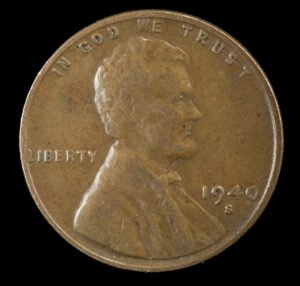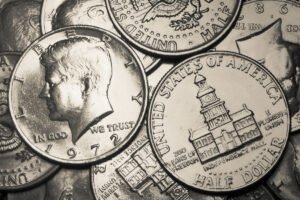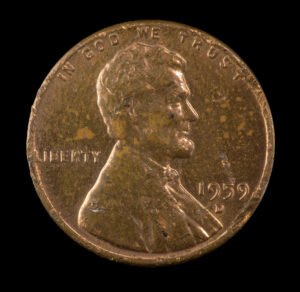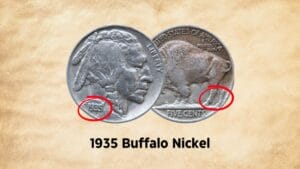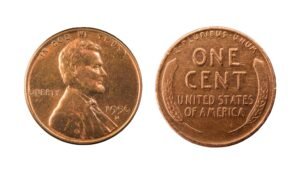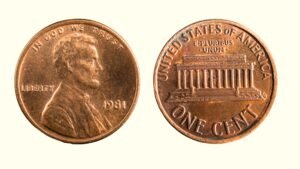Amid the World War II era, when the United States struggled to meet copper requirements for war equipment, the US Mint stopped the copper Lincoln cents. Then came the 1943 Steel Pennies, popular as “Wartime Cents” or Steel War Pennies!”
Although following the same previous design, their limited minting period make the 1943 pennies a good attraction. But appraising them is crucial as sellers can trick you into paying hundreds of dollars for a coin worth not more than 60 cents. So, I’ve brought this detailed 1943 Steel Penny value guide to save you from scams. Let’s dig in!
Key Takeaways
- The 1943 Steel Pennies are war-time pennies issued by the United States Mint during World War II to meet copper requirements in military equipment.
- The 1943 Lincoln Penny is made of 99% low-grade carbon steel with a thin zinc coating.
- Due to the high mintage of 1943 pennies, they are quite common unless they have any minting errors, like D/D, off-Strike, or off-metal errors.
- One of the rarest 1943-D Bronze Penny was sold at a staggering $17 million in 2010.
A Quick Overview of the 1943 Steel Penny History
- 1942: An Act of Congress was approved to produce the wartime cents so that the available copper material could be used for military equipment and ammunition.
- 1943: The production of special war-time cents started on February 27, 1943, using a cheap, low-grade silver core with a thin zinc coating.
- 1944: The US Treasury stopped the striking of the 1943 Steel Lincoln cents by the end of the year and retired the existing cents from circulation, making them collectible.
| 1943 Steel Penny | Key Facts |
| Material (Composition) | Carbon Steel (99%) & a thin layer of Zinc |
| Minting Location | Philadelphia, Denver, San Francisco |
| Year of Minting | 1943 |
| Weight | 2.702 grams |
| Diameter | 19.05 mm |
| Thickness | 1.55 mm |
| Designer | Victor D. Brenner |
| Face Value | $0.01 |
| Mint Marks | No Mint Mark (Philadelphia Mint)“D” Mint Mark (Denver Mint)“S” Mint Mark (San Francisco Mint) |
| Total Mintage | 1,093,838,670 (All three mints) |

Design Details of the 1943 Steel Penny
The war-time 1943 Steel Pennies were designed by the Lithuanian engraver Victor D. Brenner, who designed the entire series of the Lincoln Cent. Let’s check out the famous design of the 1943 Cent.
1. Obverse (Heads) Design:
The obverse or heads of a 1943 Steel Penny will bear the following design features:
- A right profile of the 16th President of the US, Abraham Lincoln, in a suit
- The word “LIBERTY” carved on the left side of the obverse
- The mint year “1943” on the right side (lower) of the obverse
- The phrase “IN GOD WE TRUST” relief carved along the top edge of the heads, right above Lincoln’s head
2. Reverse (Tails) Design:
Here’s what the 1943 Steel Pennies reverse or back side looks like:
- Denomination “ONE CENT” in the center of the coin
- The phrase “UNITED STATES OF AMERICA” inscribed below the denomination in smaller font
- Two wheat stalks around the ONE CENT & USA phrase
- The US motto, “E. PLURIBUS. UNUM,” inscribed along the upper edge of the reverse
3. Coin Composition & Measurements:
As the name states, a 1943 Steel Penny is made of 99% low-grade carbon steel, and the rest, 1% is a thin layer of zinc metal. This zinc-coated steel coin weighs 2.702 grams and is 19.05 mm wide (diameter) and 1.55 mm thick.
The previous Lincoln cent coins had a composition of 95% copper-based bronze. But due to a wartime shortage of copper, the Mint decided to produce the 1943 Steel Pennies!
4. Unique Identifying Mint Marks
The 1943 Steel Pennies were minted at all three mints: Philadelphia, Denver, and San Francisco Mints. Among these, the Philadelphia struck 1943 Lincoln cents have no mint marks.
1. The 1943-D Steel Penny: These 1943 Lincoln cents struck by the Denver Mint feature a small “D” mint mark below the mint date 1943 on the coin’s heads. These coins generally don’t usually cost more than $1 unless they’re in a mint state with 60 grades or higher.
2. The 1943-S Steel Penny: These Lincoln steel cents were also minted at the San Francisco Mint. You can easily spot them by the tiny “S” mint mark inscribed right below the mint date on the obverse.
3 Factors to Analyze to Find the 1943 Steel Penny Value
Let’s understand the three most important factors determining the final value of your old 1943 steel penny!
1. Condition and Grading of 1943 Steel Pennies
Being quite common and made of a cheap metal like low-grade steel, the 1943 Steel Coins don’t fetch much more than their face value in poor, worn-out, and average conditions.
But the mint state uncirculated coins, especially those with higher grades (as per the coin grading services), can be worth hundreds to a few thousand dollars. Besides, among the three mint variations, the S mint coins are more valuable than the rest.
Let’s see how the condition and grades impact the old 1943 Steel Pennies value:
| Coin’s Condition/Coin’s Name | 1943 Steel Penny | 1943-S Steel Penny | 1943-D Steel Penny |
| Poor to Very Good (VG) | Less than 20 cents | Around $1 or more | Around $1 |
| Fine to Extremely Fine (XF) | 20 cents to $1 | $1 – $7 | Up to 50 cents or more |
| Mint State (MS 50 – MS 65) | Around $25 | Up to $30 | Up to $25 (or more) |
| MS 65 or Higher Grade | $30 – $3,000 or more | $30 – $4,000 or more | $30 – $1,500 or more for higher grades |
2. Rare Anomalies & Errors in 1943 Steel Penny
The 1943 Steel Pennies were struck in huge numbers, making them easily available and common. What makes them special is the striking errors!
So, here are the three most sought-after 1943 Steel Penny errors that can hike its price like crazy!
1. (Off-Metal Transitional Error): During the striking of the 1943 War Cents, the leftover bronze planchets from 1942 were struck, resulting in a rare 1943 Copper/Bronze Penny variation.
Today, these 1943 Bronze Pennies minted at the Denver and San Francisco mints are one of the most expensive Lincoln pennies, costing up to $500,000 or above in a high-grade mint state!

2. 1943 D/D Error: This error caused the “D” mint mark to double-struck in the Denver-minted 1943 Steel Pennies. You can easily spot this error by the doubled D mint mark below the mint date.
The 1943 Steel Double Die Pennies with mint state grades of 65 or above have been auctioned at a range of $500 – $19,000.
3. Off-Center Strike Error: This error happens when the coin planchet is misplaced inside the mint die. It causes the coin design to go off-center. The price of the 1943 Steel Penny hikes with the degree of the off-strike. The low 10% off-strike coin can cost up to $150.
3. 1943 Steel Lincoln Penny Mintage & Rarity
The high mintage of the war-time 1943 Steel Pennies makes them quite easily available. Nonetheless, since these coins were only struck for one year, coin collectors love collecting these special Lincoln cents!
Below are the mintage numbers of the 1943 Steel Pennies:
| 1943 Steel Pennies | Mintage |
| 1943 Steel Penny (No Mint Mark) | 684,628,670 |
| 1943-D Steel Penny (D Mint Mark) | 217,660,000 |
| 1943-S Steel Penny (S Mint Mark) | 191,550,000 |
Is Your Old 1943 Steel Penny Real?
It’s easy to pass on a fake 1943 Steel Penny as a valuable one costing hundreds of dollars by doing some modifications. But you can easily spot a counterfeit by looking for the given traits:
- Non-magnetic composition (steel is attracted to a magnet)
- Too much varied weight than 2.7 grams
- Scratched or modified mint date (for example, the digit “8” of date “1948” altered to look like “3”)
- Copper-plated steel pennies sold as the 1943 Bronze Penny
- Modified mint marks (glued marks)
Are 1943 Steel Pennies pure steel?
During World War II, the US Mint decided to strike steel coins instead of copper for a year in 1943. All these 1943 pennies were made of 99% low-grade steel and 1% zinc-clad coating.
What 1943 penny is worth the most?
The 1943 Lincoln penny with the off-metal transitional error (steel coin struck on a bronze planchet from 1942) are one of the most expensive and sought-after 1943 pennies among collectors.
The 1943 Steel Pennies are an excellent representation of the struggles during World War II. And that’s what makes them a collectible despite their huge mintage. Similarly, the 1972 Silver Dollar is collectors’ favorite even after being quite common. Want to know why? Join me to find out more!
Note: This article is intended for informational, educational, and entertainment purposes only. Some images are illustrative and may not represent actual brands, products, or related entities. All trademarks, product names, brand logos, packaging, and other intellectual property referenced remain the exclusive property of their respective owners. Any brand mentions or references are provided solely for descriptive and educational context and do not imply any formal or commercial association.


